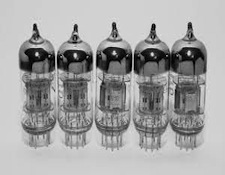It’s the time of year for saving money!

A good percentage of the audiophiles reading the statement,
“Tubes Rule!” will probably agree with it. My question to them is simple – why?
I ask the question because I wonder if there are more
insightful answers than the standard, “Tubes sound better.” We all get that
tubes distortion characteristics are more “musical” with fewer and reduced odd
order harmonics. But what audio designer in their right mind would knowingly
create an audio component that drives a tube (or solid state device) into
distortion? The exception, of course, is with guitar amps, where it’s all about
perfecting and controlling overdriven sonic characteristics.
But back to the question of why or why not tubes rule; aren’t
tubes merely a part in a circuit design? The phrase, “It’s the driver, not the
car” comes to mind. I think that today’s A-list audio designers and their best
designs aren’t about a particular part, but a synergy of parts. And depending
on which parts a designer is most familiar with, that’s probably what they’ll
use in their current and future designs.
I maintain that one of the reasons we see so many tube-based
audio products is because tubes have been and continue to be readily available
components. Most standard tubes have been available, pretty much without
interruption, for over fifty years. Literally millions of audio engineers have
experimented with, and thousands have built, components based on tube gain
stages. Because tubes have been such a constant and reliably available part, many
fine designers have chosen to use them, become familiar with them, and based
their designs around them. Cool. But, does that make tubes rule?






i don’t know if that make’s them rule. but they are my choice i love my rogue M-150 amp’s no solid state amp has allowed me to just listen and want to keep listening. im sure there are some incredible solid state amp’s that are very very good however they are out of my league. so for me i guess TUBE’S RULE!!!
Types of distortion differences between tubes and solid state can be measured. Yet? That may not even be the real reason why tubes sound better to those who prefer them.. Back in the 60’s I was in a band, The bass player had a 50 watt Fender Bassman. The band also had a 100 watt solid state head from a guitar amp that we were using for our PA. He plugged it into his Bassman speakers. We all looked at each other surprised and agreed with each other (quickly) to put the Fender head back. There was no comparison. The solid state amp put his bass tone into a straightjacket. I found the same kind of advantage in audio listening. And, I might add, I have owned some nice sounding solid state equipment. But, they could not match the transparency and depth I hear with tubes of good quality.
Tubes are better for the job. Way more head room and the don’t switch off and on like transistors.
I had the pleasure of having several conversations with Dick Sequerra over the phone. In one conversation he lamented that he was one of the early advocates for the industry going with solid state. He said it was one of the biggest errors in judgement he ever made.
Since commenting here last, I have discovered that the audio boundary does not sit on a line dividing just tubes and transistors. I have had both, and both can sound good when set up properly. Just landed in a new land that is giving me the impression that the best of both worlds has been achieved. Not all, but certain brands of digital amplification has made a leap in transparency and tightness of sound. I am very happy to discover this since last May. I like Nuforce in particular. Was considering Virtue audio as well. But, there are others as well. Digital audio will be the new frontier